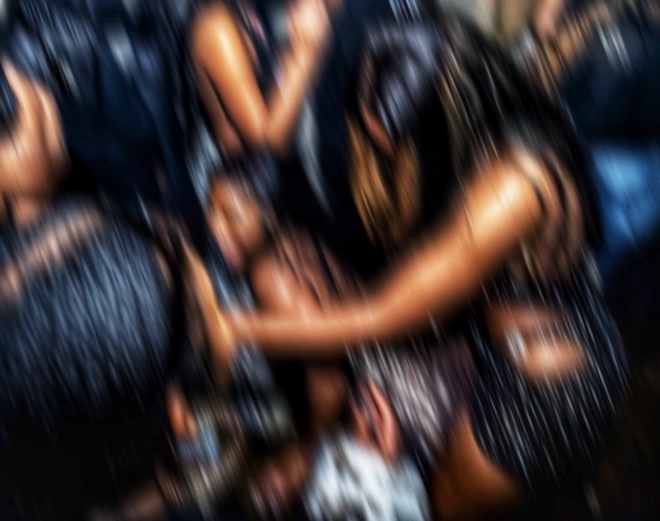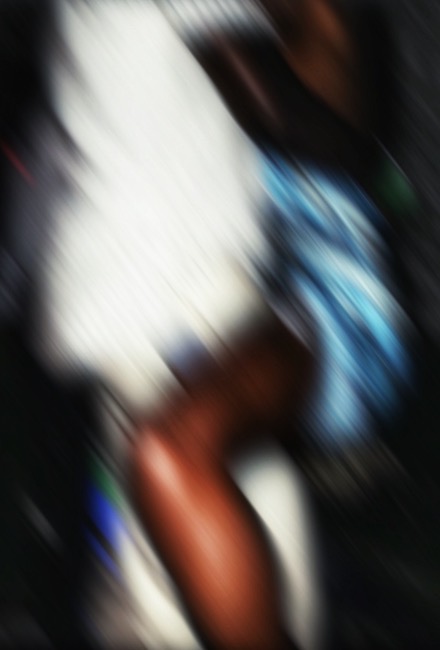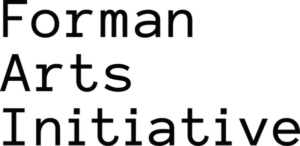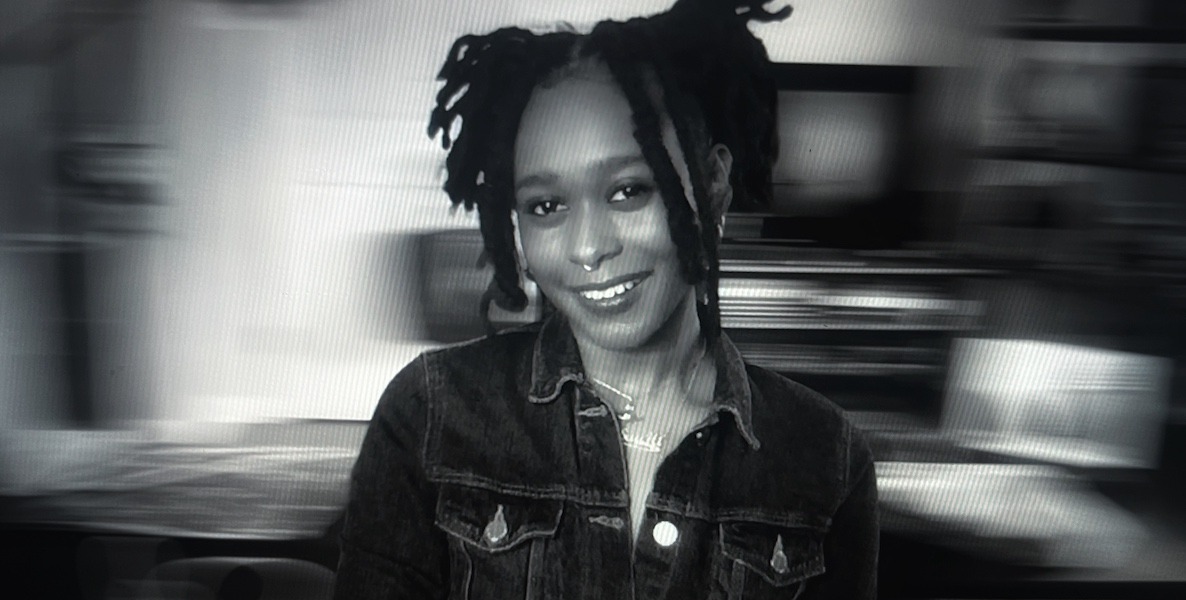Kenyssa Evans is not a big fan of social media, which might be surprising considering that she is, after all, a photographer in her 20s. Evans’s dedication to staying enigmatic reflects in her life and her artwork. Similar to the paintings made by Jennifer Packer or to the videos created by Sonda Perry, the images Evans produces capture Black people — all while obscuring the identities of those within the images. Why? Because anonymity can be a type of freedom.
Evans says that her creative process is largely intuitive. As for her aesthetic choices: “Most of the time a lot of my images are just me winging it.” Once she completes a photo, she devotes heavy contemplation towards interpreting the work. Evans explains, “I feel like with every project, I have to dive into it, take a break and come back to it.”
Valuing feeling over judgment allows Evans to slow down and create meaningful images — a tactic that is especially important because her work often features people or environments that are near to her heart. Exhibitions in Philadelphia, Seattle, Chicago and Washington, D.C. have featured Evan’s artwork.
As part of a partnership with Forman Arts Initiative, the Citizen caught up with Kenyssa Evans. The interview has been condensed and edited for clarity.
What brought you to Philadelphia?
I’m from the 202, so I’m from Washington, D.C. I went to Duke Ellington School of the Arts. It’s the first performing arts school in D.C. To get in, you’ve got to go through a whole interview process and talk about why you love art. At that time I was not, honestly, really into art. The reason I applied is otherwise I would have had to go to a Catholic school. I didn’t really understand what art was really like. Then, once I got in, the teachers there were just awesome. They introduced me to a whole new world.

Moore College of Art & Design visited my school. I don’t know, I feel like the all-woman college thing kind of lured me in — and also just all the majors that they had there, especially curatorial studies. I came to Philly for school at Moore, and I just decided to stay here. I fell in love with the city.
In your experience, what is the skill leap between an amateur taking photos versus the images a photographer in the professional world makes?
There could be a difference, but I feel like sometimes I don’t see a difference. It’s really a question of, “What is the story you’re telling? What are you’re trying to portray in these images?” A lot of artists now take snapshots on their phones, don’t really edit anything, and they have an intentional reason for doing that. It’s the intention behind it that’s always stuck with me. That’s what I feel like with my personal practice. If I don’t have an intention, then I just have no interest in it.
With me personally, I’ve been straying away from my camera. I’ve been really just using — especially with the current project I’ve been working on — I’ve been using my cellphone and taking these images.
Tell me about your current photography project.
It really started over the summer. I went to go visit my grandma and I was just in her house and she had one of [engraver/painter] Ernest Watson’s paintings. I just love how the bodies are just so distorted and how he captured those scenes [of Black life]. I just like seeing it in Black households. Summertime, being surrounded by all these cookouts and these gatherings, I was observing people and how their bodies are reacting to these environments. That’s how I started getting interested in that sonic architecture and studying different sounds from different places.
In D.C., you have Go-Go music. It originated from jazz, blues and funk. Chuck Brown was the guy that founded it. In Chicago you have house music. I remember going to church as a kid and seeing these spaces, especially for Black and brown people, and how they gather in these spaces and felt like they could be themselves and be free. I’m trying to capture those spaces in my photography, and trying to study the music more.
I’m honestly just going for it. My nights out when doing this is like me being one with everyone in that space. I’m not telling anyone, “I’m here doing my project.” I’m just like, All right, I’m going to have a drink, dance, get in the crowd. If I see something, I take a picture. I don’t even look at it. I wait until the next day. It’s a project that I’m still figuring out.
I really like to talk about space and how it affects people. That’s where my work has been honing in on. Right now I’m really diving into sonic architecture. [Editor’s note: Sonic architecture works to reconstruct architectural spaces in sound, or, vice versa, to create listening experiences as sculpture or architecture.] It all goes back to space and how one’s emotion, body and everything responds to one’s space.

Do you feel pressure to produce work really quickly? I feel like generally you move through a project very slowly..
Yeah, so that’s me all the way. I think that’s why I got off Instagram for a bit because being on Instagram, social media, whatever, and just seeing people post at work and people asking me constantly, “Oh, what are you working on? What are you working on? You haven’t posted anything. Da da da da da.” I just felt, like, this pressure. But I don’t really care what people are thinking, or if I’m being lazy about something. I just feel like I always have to take my time. Again, I’m not a person just to release, release, release. Like, “Here’s an image. You guys like it, share it.”
What does success as an artist look like to you?
Having the freedom where I have full control of my work, what I want to do, how I want to do it, and when I want to do it. I think that comes into my practice, my success as an artist. It’s just about knowing who you are as an individual and making the work for yourself. That gets blurred in the world we live in now: We’re constantly making and trying to keep up our appearance and how many followers we have.
I just want to wake up and feel okay to not work on something and not feel like, Okay, I have to work, I have to go to the studio. I have to go open my laptop and at least work on something or at least apply to exhibitions or something. I’m still trying to figure that out for myself because I do have my moments, honestly, where I’m just like, I’m not doing anything with my practice. I should be applying to this. I should be applying to that. I should be taking these opportunities.
If something’s not really gravitating me towards that opportunity, then I just kind of sit with it and I’m like I don’t feel like it’s probably right for me, or I’m probably not ready for that yet. As an artist, I just want to reach that confidence level of just being like, Okay, something is not right for me and I will be okay with it. It doesn’t feel right. I don’t want to do it. I’m okay with it.
That’s why I enjoy most of my projects a lot, because I’m just on my own time compared to my friends who are constantly working with galleries. They just always seemed drained and are trying to keep up with that. I’m not built for that to just hurry up and produce something for someone to put on their wall. I think maybe it’s just my personality type. I like being in the shadows.
Logan Cryer is a curator based in Philadelphia with a penchant for local art histories. They currently serve as the Co-Curator of Icebox Project Space and they like to rewatch documentaries.

This story is part of a partnership between The Philadelphia Citizen and Forman Arts Initiative to highlight creatives in every neighborhood in Philadelphia. It will run on both The Citizen and FAI’s websites.
![]() MORE FROM OUR ART FOR CHANGE SERIES
MORE FROM OUR ART FOR CHANGE SERIES
Kenyssa Evans, courtesy of the artist.



